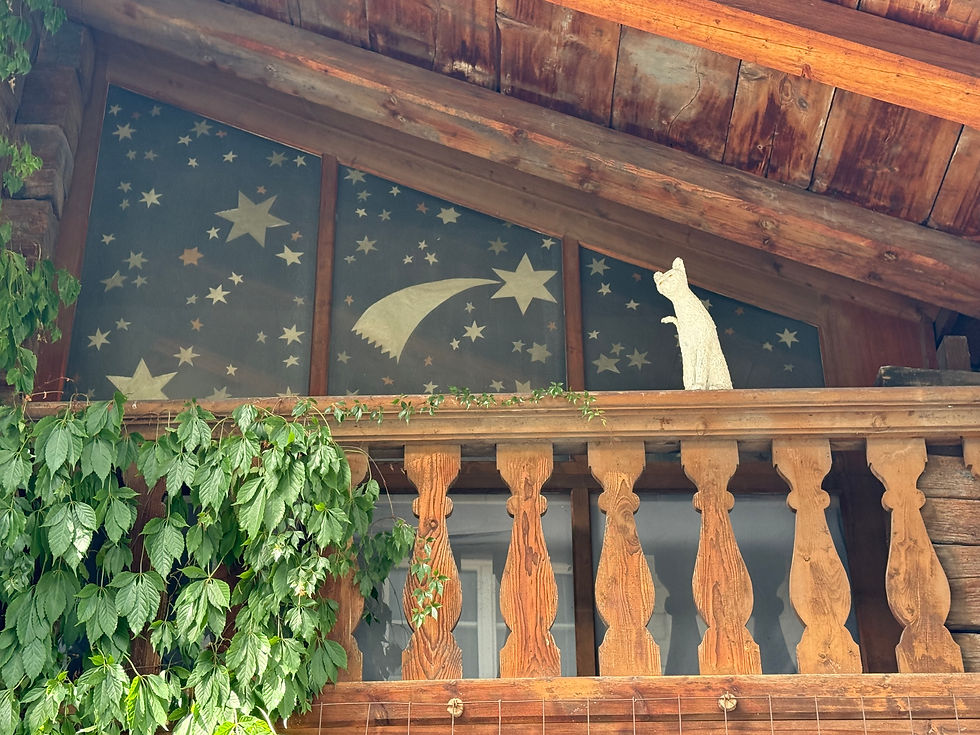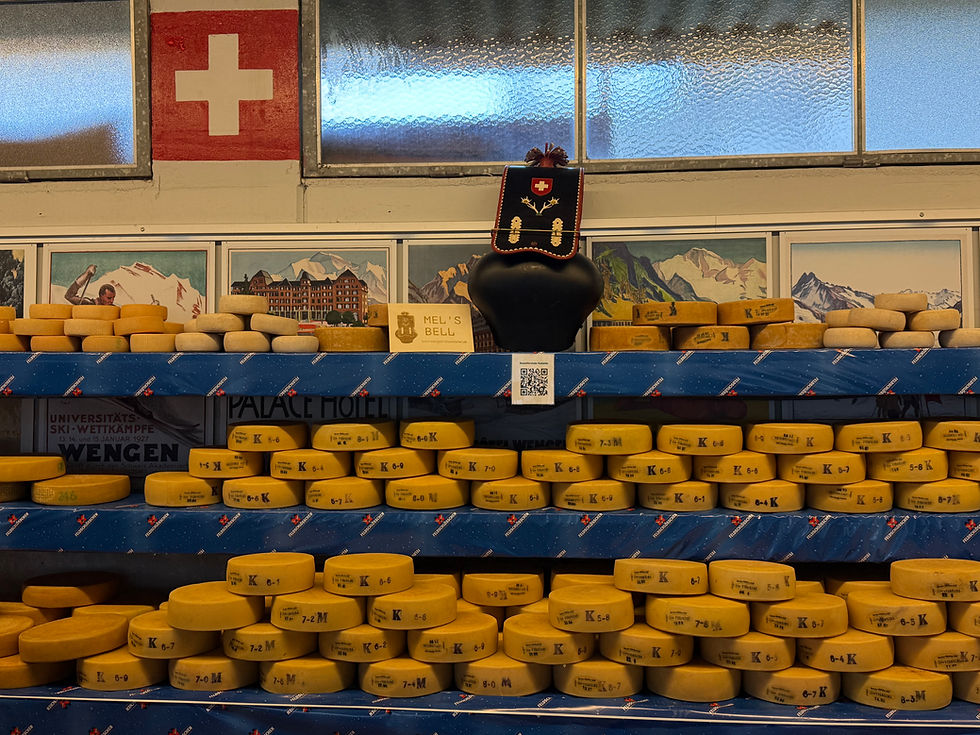Are You Looking At Me??
- Deborah Kade
- Sep 2, 2025
- 6 min read
After breakfast, Michael and I walked to the train station. On the way back home, we spotted some llamas tied to the railing by the river. The owner was waiting for a school group. What a great field trip having the llamas carry your backpacks.

Are you looking at me?

"The following characteristics apply especially to llamas. Dentition of adults: incisors 1/3 canines 1/1, premolars 2/2, molars 3/3; total 32. In the upper jaw, a compressed, sharp, pointed laniariform incisor near the hinder edge of the premaxilla is followed in the male at least by a moderate-sized, pointed, curved true canine in the anterior part of the maxilla. The isolated canine-like premolar that follows in the camels is not present. The teeth of the molar series, which are in contact with each other, consist of two very small premolars (the first almost rudimentary) and three broad molars, generally constructed like those of Camelus. In the lower jaw, the three incisors are long, spatulate, and procumbent; the outer ones are the smallest. Next to these is a curved, suberect canine, followed after an interval by an isolated minute and often deciduous simple conical premolar; then a contiguous series of one premolar and three molars, which differ from those of Camelus in having a small accessory column at the anterior outer edge."
"The skull generally resembles that of Camelus, with a larger brain cavity and orbits and less-developed cranial ridges due to its smaller size. The nasal bones are shorter and broader and are joined by the premaxilla."
"The ears are rather long and slightly curved inward, characteristically known as "banana" shaped. There is no dorsal hump. The feet are narrow, the toes being more separated than in the camels, each having a distinct plantar pad. The tail is short, and the fiber is long, woolly, and soft."
"Llamas that are well-socialized and trained to halter and lead after weaning are very friendly and pleasant to be around. They are extremely curious, and most will approach people easily. However, llamas that are bottle-fed or over-socialized and over-handled as youth will become extremely difficult to handle when mature, when they will begin to treat humans as they treat each other, which is characterized by bouts of spitting, kicking and neck wrestling."

"When correctly reared, llamas spitting at a human is a rare thing. Llamas are very social herd animals, however, and sometimes spit at each other to discipline lower-ranked llamas. A llama's social rank in a herd is never static. They can always move up or down the social ladder by picking small fights. This is usually done between males to see which will become dominant. Their fights are visually dramatic, characterized by spitting, ramming each other with their chests, neck wrestling, and kicking, mainly to knock the other off balance. The females are usually only seen spitting to control other herd members. One may determine how agitated the llama is by the materials in the spit. The more irritated the llama is, the further back into each of the three stomach compartments it will try to draw materials from for its spit."
"While the social structure might constantly change, they live as a family and care for each other. If one notices a strange noise or feels threatened, an alarm call - a loud, shrill sound that rhythmically rises and falls - is sent out, and all others become alert. They will often hum to each other as a form of communication."
"The llama's groaning noises or going "mwa" (/mwaʰ/) is often a sign of fear or anger. Unhappy or agitated llamas will lay their ears back, while ears being perked upwards is a sign of happiness or curiosity."

"Llamas are now utilized as certified therapy animals in nursing homes and hospitals. Rojo the Llama, located in the Pacific Northwest was certified in 2008. The Mayo Clinic says animal-assisted therapy can reduce pain, depression, anxiety, and fatigue. This type of therapy is growing in popularity, and several organizations throughout the United States participate."


"A full-grown llama can reach a height of 1.7 to 1.8 m (5 ft 7 in to 5 ft 11 in) at the top of the head and can weigh between 130 and 272 kg (287 and 600 lb). At maturity, males can weigh 94.74 kg, while females can weigh 102.27 kg. At birth, a baby llama (called a cria) can weigh between 9 and 14 kg (20 and 31 lb). Llamas typically live for 15 to 25 years, with some individuals surviving 30 years or more."


The llama is a domesticated South American camelid, widely used as a meat and pack animal by Andean cultures since the pre-Columbian era.
"Llamas are social animals and live with others as a herd. Their wool is soft and contains only a small amount of lanolin. Llamas can learn simple tasks after a few repetitions. When using a pack, they can carry about 25 to 30% of their body weight for 8 to 13 km (5–8 miles). The name llama (also historically spelled "lama" or "glama") was adopted by European settlers from native Peruvians."
"The ancestors of llamas are thought to have originated on the Great Plains of North America about 40 million years ago and subsequently migrated to South America about three million years ago during the Great American Interchange. By the end of the last ice age (10,000–12,000 years ago), camelids were extinct in North America. As of 2007, there were over seven million llamas and alpacas in South America. Some were imported to the United States and Canada late in the 20th century; their descendants now number more than 158,000 llamas and 100,000 alpacas."
"In Aymara mythology, llamas are important beings. The Heavenly Llama is said to drink water from the ocean and urinates as it rains. According to Aymara eschatology, llamas will return to the water springs and ponds where they come from at the end of time."


I decided to go to the village of Brienz on the northeast shore of Lake Brienz. The village's 18th-century wooden chalets and the sculptures dotted throughout the village are testimonials to a woodcarving tradition.
The name Brienz, first documented in 1146 as Briens , derives from the Celtic word brigantion , meaning "hill." It probably originally referred to a settlement on what is now the church hill above the lake.
Relaxing walk along the lake.

Ye, I'm looking at you!!!


Look out!


The water is freezing cold but people enjoy their daily swim.


I can look at you while standing on my head.




I can give the one eye stare.

You had to tilt the board and get the marble in the hole.

You can't be looking at us!

Look of love

I'm too shy so I can't look at you.



Wonder what they are looking at!





Look! It's this way!






"The Milibach stream , with its striking waterfall, overflowed its banks on August 1, 1922. It washed away a road bridge and flowed through the railway tunnel. It also overflowed its banks during the storm of August 12, 2024 , causing two injuries and damages of over €25 million; 70 people were evacuated. The tracks of the Zentralbahn were severely damaged along a stretch of approximately one kilometer, and train service could not resume until November 2024."
These houses have been abandoned since last year.







I took a movie of this Swiss scene in the window. Everything was hand carved.
This street was named the most beautiful street in Switzerland. Many people walking up and down the street taking pictures.

I'm definitely looking at you!









Look at the shooting star! Make a wish.












No, we wouldn't dare look at you!

We met Fränzi at the Waisenhaus in Thun for dinner. Marcel had a business appointment and couldn't join us.
"Located in the heart of Thun, next to the rushing Aare lock and blessed with a large terrace lined with chestnut trees, the Waisenhaus Restaurant enchants with its almost fairytale-like ambience."


Michael had the Branzino alla griglia con timo e limone, servito con verdure di stagione (220g)
Grillierter Wolfsbarsch mit Thymian und Zitrone, serviert mit saisonalem Gemüse (220g)

Grüner oder gemischter Saisonsalat

Fränzi had the Paccheri an gelber Piennolo-Tomatensauce mit geräuchertem Provola-Käse aus Agerola,
Kapernblättern, Colatura di Alici aus Cetara und Zitrone

I had the Ravioli ripieni di crema di bufala e spinaci al burro e salvia
Ravioli gefüllt mit Büffelmozzarellacrème und Spinat an Salbeibutter

Yes, Michael and I were looking at the mountains on our way home.






Comments